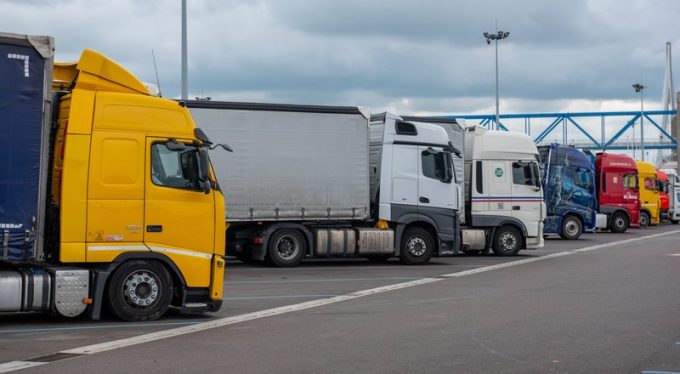'Partial win' for UK supply chains as EC delays potentially disruptive checks
Efforts at restoring EU-UK relations appear to have made some headway, the bloc agreeing to ...
TFII: SOLID AS USUALMAERSK: WEAKENINGF: FALLING OFF A CLIFFAAPL: 'BOTTLENECK IN MAINLAND CHINA'AAPL: CHINA TRENDSDHL: GROWTH CAPEXR: ANOTHER SOLID DELIVERYMFT: HERE COMES THE FALLDSV: LOOK AT SCHENKER PERFORMANCEUPS: A WAVE OF DOWNGRADES DSV: BARGAIN BINKNX: EARNINGS OUTODFL: RISING AND FALLING AND THEN RISING
TFII: SOLID AS USUALMAERSK: WEAKENINGF: FALLING OFF A CLIFFAAPL: 'BOTTLENECK IN MAINLAND CHINA'AAPL: CHINA TRENDSDHL: GROWTH CAPEXR: ANOTHER SOLID DELIVERYMFT: HERE COMES THE FALLDSV: LOOK AT SCHENKER PERFORMANCEUPS: A WAVE OF DOWNGRADES DSV: BARGAIN BINKNX: EARNINGS OUTODFL: RISING AND FALLING AND THEN RISING

Post-Brexit regulations are generating fears of trailer shortages and surging freight rates that could resemble those seen across ocean container supply chains.
Sources have told The Loadstar EU-based truck drivers are refusing to come to the UK unless there’s a back load, or the importer covers the cost of the empty return leg.
They are citing additional time and heightened bureaucracy, with concerns that as volumes pick up, so too will delays and rates.
“No one can argue that volumes are down, the RHA [Road Haulage Association] is reporting a 20-30% drop on the yearly average,” one source said.
“Even when things pick up, I cannot see it getting any easier. The biggest challenge then will not be customs formalities but persuading drivers to move goods here when they can get the same rates for less time on an intra-EU trip.”
Without drivers, there is a growing worry that trailers left in the UK will eat into wider European capacity, causing freight rates to soar on both sides of the Channel.
This is being compared to what was seen across ports late last year in countries with a trade imbalance with China, after blanked sailings – throughout March and April resulting from the pandemic – interrupted trade flows, leaving empty containers stranded.
Gradually, the absence of empty boxes being returned to China led to a container shortage for exports, forcing freight rates to climb exponentially.
But it is not just on UK-EU routes that alarm bells are ringing, with one source telling The Loadstar that trailer availability in Northern Ireland was already down.
The source said: “We’re aware of trailers that have been used to export goods from Northern Ireland to Great Britain being left there, as it’s easier for drivers to do that than to bring them back here with all the new formalities.”
RHA spokesperson Paul Mummery told The Loadstar it was “totally understandable” that drivers were charging higher rates, as trips were taking significantly longer.
Whether it would result in a shortage of trailer stock and associated rate spikes, he said, “we’re in crystal ball territory”.
Shipment visibility platform Transporeon’s Brexit Market Monitor said rejection rates on Germany-UK, France-UK, Italy-UK and Poland-UK routes were all up 74% to 158% on the previous week.
Mr Mummery and a customs source suggested part of the problem surrounding rejection rates for UK-bound goods was poor messaging linked to requirements for the Kent access permit (KAP).
“We’ve already seen the consequences, as large numbers of those caught without a KAP are not from the UK,” said Mr Mummery. “These drivers are getting fined £300, which we think is very unfair because it’s a rule they were likely not aware of, having not been party to the messaging.”
However, Mr Mummery acknowledged that providing messaging for the entire sector was a hugely difficult task, due to the industry’s fragmented structure.
So, he said, it made sense for the UK and EU to agree to an grace period, providing drivers time to adjust to the new regulations rather than face penalties for rules they were unaware of.
Illustrating the confusion and frustration of the new regulations was video footage of a driver having his ham sandwich confiscated in the Netherlands as a meat import.
One source said: “That type of scenario is just ridiculous, and it can be solved by looking at the processes – it’s not about standards, the EU and UK share the same food standards.”
And alongside Brexit and Covid-19, the transport sector has been dealing with the perennial driver shortage, which the RHA estimated at around 60,000 for the UK alone, prior to Brexit, with expectations that number will now climb.
“The UK leaving EU has only made this situation more difficult, with it being harder to recruit drivers,” Mr Mummery continued.
“It all puts strain on UK trade, with concern filtering down to drivers … we’ve really only seen beginning of it. As demand increases, it will put pressure on the workforce,” he added.
According to Andy Ralls, quantitative researcher at Transport Intelligence, the number of HGV drivers in the UK currently receiving unemployment benefits stands at just 100.
Comment on this article